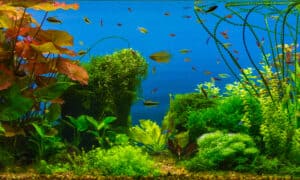| Best for | Product |
|---|---|
| Best Overall | Stoney River White Aquatic Sand |
| Best for Freshwater Aquariums | CaribSea Super Naturals Moonlight Freshwater Sand |
| Best for Saltwater Aquariums | AquaNatural Oolitic Aragonite Aquarium Sand |
| Best Colored Sand | Aqua Terra Aquarium & Terrarium Sand |
| Best Live Sand | CaribSea Ocean Direct Original Caribbean Marine Live Sand |
If you’re new to the aquarium hobby, you may believe that sand is sand. Amazingly, nothing could be further from the truth. First, you need to decide whether you want to use aquarium sand, live sand, pool filter sand, or play sand in the tank. Since we prefer to use aquarium sand and live sand in our tanks, those are the types that we discussed in this review.
The proper sand will do more than make the tank look attractive. It will provide a medium for beneficial bacteria. These “good” bacteria break the ammonia from fish urine and waste into nitrites. Then they turn the nitrites into nitrates, which are safer for your pets. In addition, the perfect sand will anchor the aquatic plants (genuine or artificial) to the aquarium floor.
We’ve reviewed and ranked the best aquarium sand and live sand so you can start creating the aquarium of your dreams.
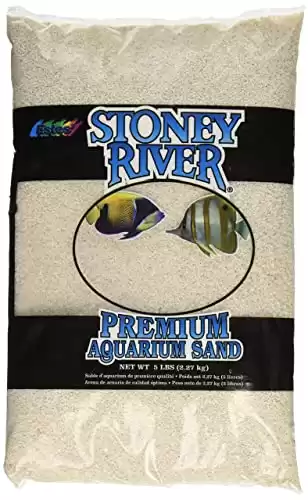 Check Amazon
Check Amazon- Safe for freshwater and saltwater
- Non-toxic coating
- Doesn't impact water's pH
- Highlights fishes' natural colors
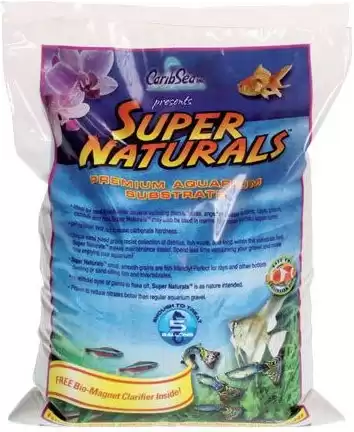 Check Chewy Check Amazon
Check Chewy Check Amazon- Natural sand, no dyes or paints
- pH Neutral
- Can be used in fresh or saltwater
- Easy to clean
 Check Amazon
Check Amazon- Best for marine or cichlid tank
- Will keep pH stable at 8.2
- Contains no impurities
- Won't injure fish that burrow in the sand
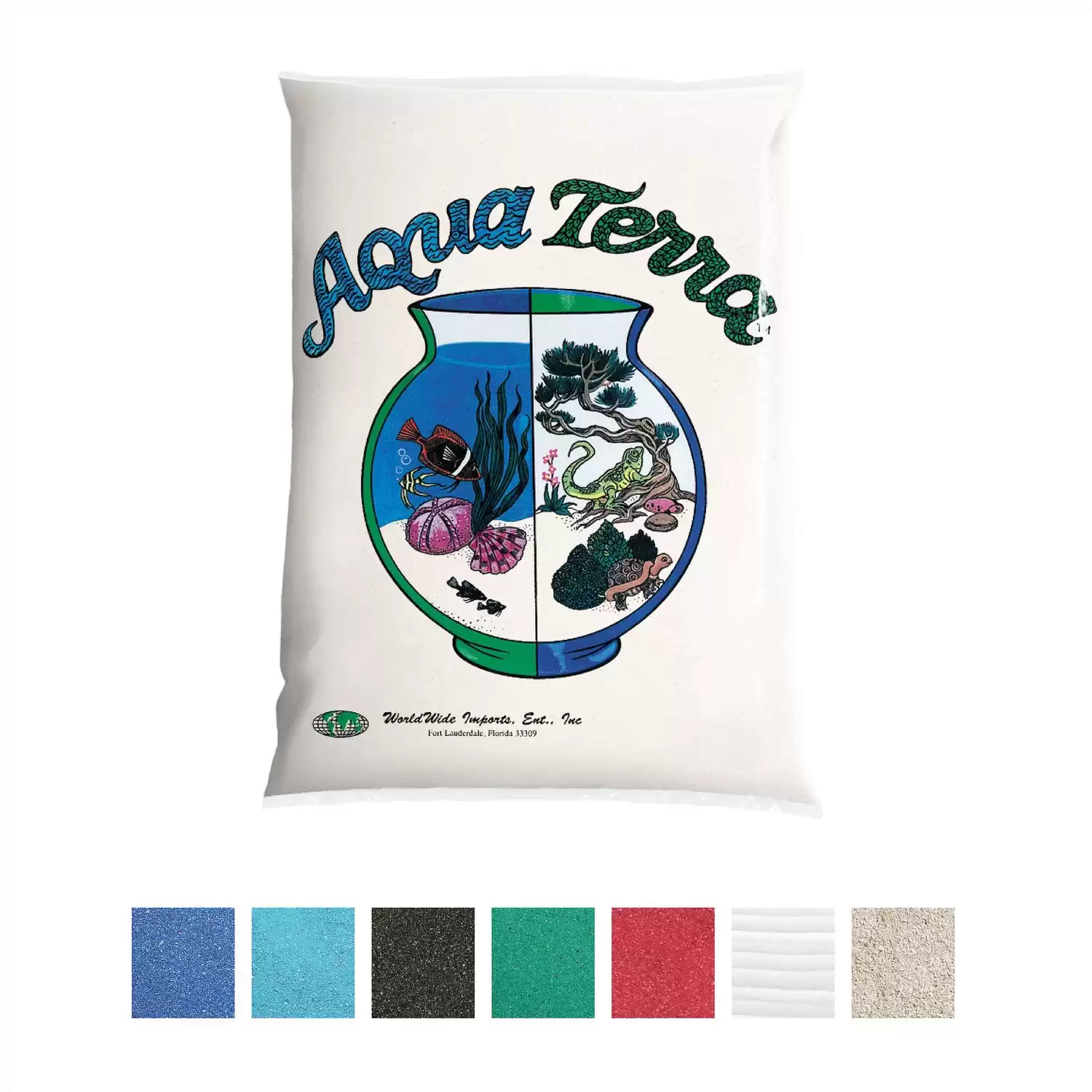 Check Chewy
Check Chewy- Very popular among hobbyists
- Very reasonably priced
- Available in 7 colors
- Has a colorfast, 100% acrylic coating
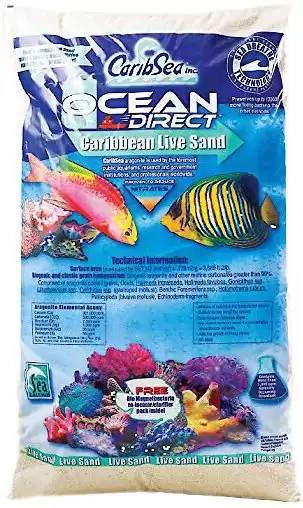 Check Chewy Check Amazon
Check Chewy Check Amazon- Contains the original marine bacteria
- pH-neutral
- Very attractive aragonite sand
- Ideal for bottom-dwelling fish
A-Z-Animals Top Picks for Aquarium Sand for Your Pet Fish
#1 Best Overall: Stoney River White Aquatic Sand
Our choice for the best overall sand is Stoney River White Aquatic Sand.
This sand is safe for freshwater and saltwater (also known as marine) aquariums. It has a non-toxic coating and it won’t affect your water’s pH. Plus, waste collects on top of the sand making maintenance easy.
This bright white sand will highlight the fish’s natural colors so they can be the stars of your tank. And this fine-grained sand makes the perfect substrate to anchor aquatic plants so they can thrive.
Unfortunately, some customers reported that this sand was quite dusty.
Pros and Cons of the Stoney River White Aquatic Sand
| Pros | Cons |
|---|---|
| This sand is safe for freshwater and saltwater aquariums. | Some customers reported it was quite dusty. |
| It has a non-toxic coating. | |
| It does not alter the pH of the water. | |
| Waste collects on top of the sand which makes cleaning easier. | |
| This sand is fine-grained and has a bright white color. |
- Safe for freshwater and saltwater
- Non-toxic coating
- Doesn't impact water's pH
- Highlights fishes' natural colors
2. Best for Freshwater Aquariums: CaribSea Super Naturals Moonlight Sand
For freshwater aquariums we recommend the CaribSea Super Naturals Moonlight Sand.
This sand is a gorgeous, natural white that hasn’t been treated with dyes or paints. Under certain conditions, this shiny sand appears almost luminous, like a beach in the moonlight.
This beautiful sand is pH neutral and can be used in freshwater or saltwater, but we prefer it for the former. (We also have suggestions for readers who keep saltwater creatures.) It’s heavy, so the aquatic plants won’t just float away. It’s also easy to clean with a sand vacuum because fish waste and excess food accumulate on the surface.
However, some customers reported that it made their tank water cloudy.
Pros and Cons of the CaribSea Super Naturals Moonlight Sand
| Pros | Cons |
|---|---|
| This sand is a natural white color and has not been treated with dyes or paints. | Some customers reported that it made the tank water cloudy. |
| It can be used in both freshwater and saltwater. | |
| It has a neutral pH. | |
| It is great for anchoring plants due to its heavy weight. |
- Natural sand, no dyes or paints
- pH Neutral
- Can be used in fresh or saltwater
- Easy to clean
3. Best for Saltwater Aquariums: AquaNatural Oolitic Aragonite Aquarium Sand
If you have a saltwater tank then the AquaNatural Oolitic Aragonite Aquarium Sand is the perfect choice.
Aragonite is a naturally occurring crystal comprised of calcium carbonate. Because it’s 98% calcium carbonate, unlike other sands it has zero impurities. And it will keep your tank’s pH stable at 8.2, without chemical buffers. In addition, one kilogram of this sand has more than one million square centimeters of surface area where beneficial bacteria that reduce ammonia, nitrates, and nitrites can flourish.
The manufacturer, Pisces USA, is the only company licensed by The Bahamian government to collect Oolitic Aragonite sand from their pristine ocean. They harvest this renewable, sustainable resource ethically, so it’s a great choice not only for your tank but for the environment.
The only drawback to this product is that the color of the sand sometimes varies between bags.
Pros and Cons of the AquaNatural Oolitic Aragonite Aquarium Sand
| Pros | Cons |
|---|---|
| This sand will keep your tank’s pH stable at 8.2, without chemical buffers. | The color varies between bags. |
| It does not have any impurities. | |
| One kilogram of this sand has more than one million square centimeters of surface area. | |
| It is made from naturally occurring aragonite from a sustainable source. |
- Best for marine or cichlid tank
- Will keep pH stable at 8.2
- Contains no impurities
- Won't injure fish that burrow in the sand
4. Best Colored Sand: Aqua Terra Aquarium Sand
Colored sand is popular among aquarium hobbyists as many like to coordinate the sand with their home’s décor or with the colors of their fish. Therefore, we recommend the Aqua Terra Aquarium Sand.
Our choice for the best colored sand, Aqua Terra, is also the best bargain brand at $4.99 per 5-lb bag or less. It’s available in seven vibrant colors: dark blue, light blue, black, green, red, white, and natural. It features a colorfast, 100% acrylic coating that’s safe for your water and your fish.
This sand aids the filtration process by increasing the surface area where beneficial microbes can colonize. It also anchors plants so they can take root and flourish.
Unfortunately, it appears that some colors are more scarce than others.
Pros and Cons of the Aqua Terra Aquarium Sand
| Pros | Cons |
|---|---|
| This sand is available in seven vibrant colors. | Some colors are more scarce than others. |
| It features an acrylic coating that is safe for the water and fish. | |
| It aids the filtration process by increasing the surface area where beneficial microbes can colonize. |
- Very popular among hobbyists
- Very reasonably priced
- Available in 7 colors
- Has a colorfast, 100% acrylic coating
5. Best Live Sand: CaribSea Ocean Direct Original Caribbean Marine Live Sand
Our selection as the best live sand is the CaribSea Ocean Direct Original Caribbean Marine Live Sand.
CaribSea utilizes “Sea-Breathe” technology. This unique packing method conserves the original marine bacteria your saltwater friends need to thrive. In fact, each bag contains up to 1,000 more marine bacteria than other brands!
Each bag of high-quality sand is moist packed, which encapsulates each grain with real seawater. This attractive, live, pH-neutral aragonite sand will cycle your saltwater tank to the optimal natural balance that your finned friends require. Plus, this sand’s soft, fine grains make it ideal for bottom-dwelling fish.
Be sure to follow the manufacturer’s instructions and don’t rinse the sand prior to introducing it to the tank. Rinsing will flush away the beneficial marine bacteria. Unfortunately, as it is not to be rinsed it does sometimes result in the water being cloudy for a few days after adding.
Pros and Cons of the CaribSea Ocean Direct Original Caribbean Marine Live Sand
| Pros | Cons |
|---|---|
| This sand has soft, fine grains that are ideal for bottom-dwelling fish. | It makes the water cloudy for the first few days. |
| The manufacturer utilizes “Sea-Breathe” technology to conserve the original marine bacteria in the sand. | |
| It has a neutral pH. | |
| Each bag contains up to 1,000 more marine bacteria than other brands. |
- Contains the original marine bacteria
- pH-neutral
- Very attractive aragonite sand
- Ideal for bottom-dwelling fish
Choosing the Best Aquarium Sand: What to Look For
When you’re shopping for the best aquarium sand, consider three main factors: type of sand, color, and price.
Type of Sand
Some varieties of sand can be used in freshwater and saltwater aquariums. Others can only be used in saltwater tanks because the live bacteria are only beneficial for marine creatures. It’s important to select the type that’s best for your tank.
Color
Sand is available in assorted colors. You can find natural sand that’s white, off-white, brown, pink, or black. Artificially colored aquarium sand comes in vivid colors like, red, blue, and green. These are often coated with color-fast, 100% acrylic that won’t affect the pH of your water or the health of your fish.
Types of Aquarium Sand: Pros and Cons Compared
The chart below explains the use case for each type of sand. It also demonstrates the pros and cons of each type.
Aquarium Sand
| Pros | Cons |
|---|---|
| It can be used in freshwater and saltwater tanks. | It must be rinsed well before you put it in the tank in order to avoid cloudiness. |
| Available in various colors and particle sizes. | |
| Many have a safe acrylic coating. |
Live Sand
| Pros | Cons |
|---|---|
| It is specially packaged for saltwater tanks. | It should not be used in freshwater tanks because the healthy bacteria and micro-organisms are saltwater-specific. |
| Contains healthy bacteria and tiny organisms that will enhance the biodiversity of a saltwater tank. | |
| Tanks cycle faster when live sand is added. | |
| It is harvested live or cultured by the manufacturer. |
Up Next
- The Best Aquarium Cabinets — Find the best cabinet for your aquarium here.
- The Best Fish Tank Aquarium Stands — Check out these stunning aquarium stands!
- The Top Aquaponics Fish Tanks — Find the very best Aquaponics fish tank here.
| Best for | Product |
|---|---|
| Best Overall | Stoney River White Aquatic Sand |
| Best for Freshwater Aquariums | CaribSea Super Naturals Moonlight Freshwater Sand |
| Best for Saltwater Aquariums | AquaNatural Oolitic Aragonite Aquarium Sand |
| Best Colored Sand | Aqua Terra Aquarium & Terrarium Sand |
| Best Live Sand | CaribSea Ocean Direct Original Caribbean Marine Live Sand |
The Best Aquarium Sand for Your Pet Fish FAQs (Frequently Asked Questions)
Is colored sand safe for aquariums?
Yes! Premium-quality colored aquarium sand has been treated with 100% acrylic. After it cures, it is completely safe. It won’t adversely affect your tank’s water quality or impact your fish.
What is live sand?
Live sand is colonized by beneficial bacteria and micro-organisms that help your saltwater tank cycle more quickly. Most is natural coral reef sand collected from the ocean that is packaged to preserve these beneficial properties. Some is “dead” sand to which the manufacturer added living “cultures.”
Which is a better aquarium substrate: sand or gravel?
Experts prefer sand because it provides more surface area where beneficial bacteria can grow. Also, waste from fish and uneaten food tends to accumulate between pieces of gravel. Because sand is fine, waste tends to accumulate on the surface where it’s easy to remove with a sand vacuum.
Thank you for reading! Have some feedback for us? Contact the AZ Animals editorial team.



